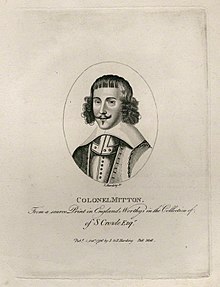Thomas Mytton
Thomas Mytton | |
|---|---|
 Thomas Mytton, 1796 engraving of original portrait | |
| Member of Parliament for Shropshire | |
| In office September 1654 – January 1655 | |
| Vice-admiral, North Wales | |
| In office 1647–1649 | |
| High Sheriff of Shropshire | |
| In office 1644–1645 | |
| Personal details | |
| Born | 1597 Major General |
| Battles/wars | Wars of the Three Kingdoms Oswestry; Montgomery Castle; Denbigh Green; North Wales campaign 1646; Battle of Red Hill 1648 |
Part of a long-established local family, Mytton was one of the few members of the mostly Royalist Shropshire gentry to support Parliament. Despite his lack of military experience, he proved a determined and competent officer, eventually rising to command operations in North Wales. In December 1647 he was also appointed Vice-admiral, North Wales.
After helping to suppress a rising in North Wales during the 1648 Second English Civil War, he resigned his military posts and was appointed MP in 1654. He died in London and was buried in the churchyard of St Chad's Church, Shrewsbury on 29 November.
Personal details
Thomas Mytton was born in 1597, only surviving son of Richard Mytton of
In 1629, Mytton married Magdalen Napier (1610-1648), daughter of
Early career and First Civil War
After attending
When the First English Civil War began in August 1642, the regional centre of Shrewsbury was used to assemble recruits and supplies from Royalist areas in Wales and the North West, making the area important to both sides in June 1643, Parliament appointed the Earl of Denbigh military commander of Shropshire, Warwickshire, Worcestershire and Staffordshire, Sir Thomas Myddelton filling the same role in North Wales.[6]
Mytton raised an infantry regiment in Cheshire and joined Myddelton to take Wem in September 1643, becoming Governor of the first Parliamentarian garrison in Shropshire (see Map).[7] For the next twelve months, he used the town as a base for operations in support of Sir William Brereton's campaign against Chester and other Royalist positions in the region. Tensions developed with local Parliamentarians whom he accused of refusing to follow orders, a dispute that influenced subsequent events.[5]
In June 1644, he and Denbigh took Oswestry, isolating Shrewsbury from Chester and providing a route for Parliamentarian offensives into Wales.[8] A joint offensive with Myddleton led to the capture of Montgomery Castle in early September, while a Royalist attempt to retake it was repulsed on 18th in the biggest battle of the war in Wales and a major victory for Parliament.[9] The new Parliamentarian governor was Sir John Pryce, a Royalist defector who switched sides again in May 1645.[10]
His capture of Shrewsbury on 22 February 1645 forced the evacuation of remaining Royalist garrisons in central Shropshire, but local opposition to the appointment meant he did not become Governor.
When Myddelton and Denbigh resigned their military offices in April 1645 under the
Second Civil War and Interregnum

Arguments over the settlement with Charles led to conflict between moderate MPs, who held a majority in Parliament, and a radical minority, who were supported by the New Model Army. The economic cost of the war, a poor 1646 harvest, and recurrence of the plague meant by March 1647 the troops in Wales had not been paid for eighteen months, while the New Model was owed over £3 million, an enormous sum at the time. Parliament ordered it to Ireland, stating only those who agreed would be paid; when their representatives demanded full payment for all in advance, the army was disbanded on 8 April 1647.[15]
Since his troops were not part of the New Model, Mytton retained his position. In December, he was appointed Vice-admiral of North Wales in place of Thomas Glynn and granted £5,000 of confiscated Royalist estates.[5] The Second English Civil War began in April 1648 when unpaid Parliamentarian garrisons in South Wales defected but Mytton remained loyal. The revolt in the south was quickly suppressed, that in the north collapsed after he and Myddelton defeated a Royalist force at Red Hill on 1 October and recaptured Beaumaris Castle.[16]
This ended his military career and he played a relatively minor role under the
Footnotes
References
- ^ St Chads.
- ^ Ibbetsen 2004.
- ^ Helms 1983.
- ^ Williams.
- ^ a b c d Roberts 2004.
- ^ Hutton 2003, pp. 64–65.
- ^ BCW.
- ^ Hutton 2003, p. 147.
- ^ Plant.
- ^ Hutton 2003, pp. 174–175.
- ^ Hutton 2003, pp. 150–151.
- ^ Royle 2004, p. 277.
- ^ Hutton 2003, p. 197.
- ^ Hutton 2003, pp. 198–200.
- ^ Rees 2016, pp. 173–174.
- ^ Royle 2004, p. 440.
Sources
- BCW. "Colonel Thomas Mytton's Regiment of Foot". BCW Project. Retrieved 24 March 2021.
- Helms, MW (1983). ACTON, Sir Walter, 2nd Bt. (c.1621-65), of Aldenham Hall, Salop in The History of Parliament: the House of Commons 1660-1690. Boydell & Brewer. Retrieved 25 March 2021.
- Hutton, Ronald (2003). The Royalist War Effort 1642–1646. Routledge. ISBN 978-0-415-30540-2.
- Ibbetsen, David (2004). "Owen, Thomas (died 1598)". doi:10.1093/ref:odnb/21032. (Subscription or UK public library membershiprequired.)
- Plant. "Battle of Montgomery". BCW Project. Retrieved 25 March 2021.
- Rees, John (2016). The Leveller Revolution. Verso. ISBN 978-1-78478-390-7.
- Roberts, Stephen (2004). "Mytton, Thomas". doi:10.1093/ref:odnb/19714. (Subscription or UK public library membershiprequired.)
- Royle, Trevor (2004). Civil War: The Wars of the Three Kingdoms 1638–1660 (2006 ed.). Abacus. ISBN 978-0-349-11564-1.
- St Chads. "History of St Chad's with St Mary's, Shrewsbury". St Chads Church. Retrieved 25 March 2021.
- Williams, Richard. "Mytton of Halston". Retrieved 23 March 2021.

